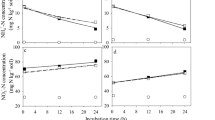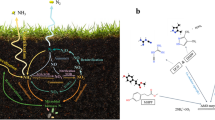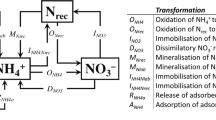Abstract.
In a 3-year field experiment, the effect of the nitrification inhibitor (NI) 3,4-dimethylpyrazole phosphate (DMPP) on the release of N2O, CO2, and on CH4 oxidation, was examined in comparison to that of dicyandiamide (DCD) on N-fertilized and unfertilized experimental sites. Soil samples were analysed simultaneously for the concentrations of N2O retained in the soil body, NH4 +, NO2 –, NO3 –, and for the degradation kinetics of DMPP as well as DCD. DMPP decreased the release of N2O on fertilized plots by 41% (1997), 47% (1998) and 53% (1999) (on average by 49%) while DCD reduced N2O emissions by 30% (1997), 22% (1998) and 29% (1999) (on average by 26%). In addition, the NIs seemed to decrease the CO2 emissions of each fertilized treatment. DCD reduced the release of CO2 by an average of 7% for the 3 years (non-fertilized 10%), and DMPP reduced it by an average of up to 28% (non-fertilized 29%). Furthermore, both NIs failed to affect CH4 oxidation negatively. The plots that received either DCD or DMPP even seemed to function as enhanced sinks for atmospheric CH4. DMPP apparently stimulated CH4 oxidation of N-fertilized plots by ca 28% in comparison to the control. In total, DCD and DMPP reduced the global warming potential of N-fertilized plots by 7% and 30%, respectively. Further, DCD and DMPP diminished the amount of N2O retained in the soil by 52% and 61%, respectively. The concentrations of NH4 + remained unaffected by both NIs, whereas the amounts of NO2 – diminished in the plots treated with DCD by 25% and with DMPP by 20%. In both NI treatments NO3 – concentrations in the soil were 23% lower than in the control. DMPP and DCD did not affect the yields of summer barley, maize and winter wheat significantly. DCD was mineralized more rapidly than DMPP.
Similar content being viewed by others
Author information
Authors and Affiliations
Additional information
Electronic Publication
Rights and permissions
About this article
Cite this article
Weiske, .A., Benckiser, .G., Herbert, .T. et al. Influence of the nitrification inhibitor 3,4-dimethylpyrazole phosphate (DMPP) in comparison to dicyandiamide (DCD) on nitrous oxide emissions, carbon dioxide fluxes and methane oxidation during 3 years of repeated application in field experiments. Biol Fertil Soils 34, 109–117 (2001). https://doi.org/10.1007/s003740100386
Received:
Issue Date:
DOI: https://doi.org/10.1007/s003740100386




